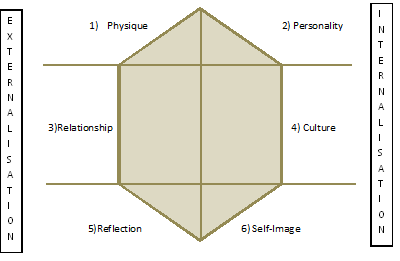As humans, as organizations, as products, as services and as nations each one makes an effort to create an identity of its own because Identity provides meaning, harmony and purpose in our life. It evolves as we grow through lifecycle. Without identity, it’s almost unfeasible to create meaning and purpose.
A corporate identity or corporate image is the manner which a firm or business presents itself to the public and all stakeholders. Creating a suitable identity is a primary goal of the corporate communication. For positioning a brand in customers mind having a robust and recognizable brand identity is essential for distinguishing it from other products in cluttered market. The identity needs to be crafted in a certain way using particular elements of that brand such as the logo, tagline, tone, or colours, packing, ingredients etc.
Brand identity is the meaning of the brand which the marketer projects and its efficacy can be measured. In 1996, Jean-Noel Kapferer, a professor of Marketing Strategy at HEC Paris, came up with the idea of representing brand identity as a hexagonal prism, with each side standing for one of these essential elements: Physique, Relationship and Reflection are the external factors of a brand whereas Personality, Culture and Self-image are internal factors. Successful brands are the ones in which all of these six facets are carefully intertwined and aligned. Kapferer’s brand identity uses traits of human being for a metaphor of a brand.
Physique: The first facet of the brand identity prism refers to the underlying physical characteristics of a brand. Physique portrays the form, size, and development of a product. The physique of a brand turns abstract and elusive characteristics into something visible. The physique helps consumers get associated with the brand initially. When you see the iPhone of Apple you get attracted to its elegance, style, and aesthetics.
Personality: it is the combination of characteristics or qualities that form an individual’s distinctive character. This element is about the character of a brand. Brand personality is developed by attributing human characteristics to it because consumer can relate to the brand easily. Toyota Innova has built a reputation of being rugged, dependable, comfortable, highest level of safety. Brands hire celebrities to endorse the product’s personality.
Relationship: It refers to the relationship between a brand and its customers in terms of what the consumers, think, feel, and how they pursue the brand. Favorable relationship helps managers and stakeholders understand how to create favorable brand approach to drive brand loyalty, repeat purchase, customer lifetime value, customer advocacy, and communities of like-minded individuals organized around brand. The approach adopted by the marketer is important in terms of which human traits describe this relationship.
Netflix – the video streaming company is known for its obsession with customers; Netflix collects a huge amount of data on customers to create hyper-personalized recommendations. It uses that data to help customers find their new favorite shows and to create award-winning original content that is exactly what customers want to see.
Culture: It can be defined as the inherent DNA that runs into the organization. It consists of the values, expressions and interactions the organization creates with the customers, employees, and all stakeholders at every point. The culture consists even of country of origin, the nation where a product is produced or branded. For example, all over world, people favor cars produced in Japan for its culture and values and its demographics. Honda, Mazda, Nissan, Toyota are respected brands in world of automobiles.
Nevertheless, Kapferer also gives another insight on culture; he says that some brands have managed to capitalize on false origination than its original; famous American brand ‘Mars’ has made Dutch people believe that it is originated in their country, Mars has got adjusted to the Dutch culture and values.
Reflection: There is a subtle but sizeable difference between self-image and reflection. While the former is about the customers’ idea of self, the latter is how brands pursue their audience. Reflection can be described as a set of stereotypical notions of a brand’s customer base, used for promotional purposes, and highlighted in ads and commercials. It is a new framework to help brand owners and advertising agencies to understand and communicate brand identity more effectively. Brand Reflections is especially useful for branding by marketing agencies to accelerate the positioning process of a brand in a certain segment. Brand reflection represents the distinctive class of users of a brand.
For example, in an Indian man’s wardrobe, his suits have a special place; nicely dry-cleaned, neatly hung and properly matched with accessories from top to bottom. Among many other brands, at least one of the suits in the wardrobe is a Raymond suit. The tag line “Complete Man” suits the Indian man’s psyche. The Complete Man describes a beautiful soul and a quintessence of individual spirit beyond gender specifics.
Self-image: Is about how customers of a particular brand see themselves; the brands get the benefit from incorporating the unique association created by the customers into creating its own identity. Most youngsters like to be tagged as “cool”, “stylish”, “vibrant” etc; they therefore choose brands which help them ascertain those tags. A research on brand identity has found that people who struggle with identity disorders gain real insight into themselves by choosing the “right” brands. Perfumes help consumers to boost their self worth. Arpege Lanvin a famous French perfume which is used by stylish and classy women. It is known for restoring feelings of self-worth in many women for decades. Its catchy tagline “No bottles to break – just hearts” says it all.














































